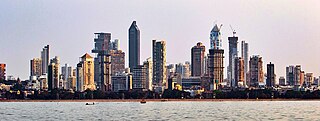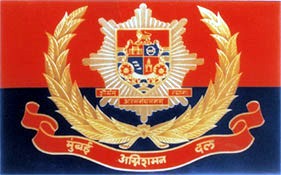
Mumbai is the capital city of the Indian state of Maharashtra. Mumbai is the financial capital and the most populous city of India with an estimated population of 12.5 million (1.25 crore). Mumbai is the centre of the Mumbai Metropolitan Region, the sixth-most populous metropolitan area in the world with a population of over 23 million. Mumbai lies on the Konkan coast on the west coast of India and has a deep natural harbour. In 2008, Mumbai was named an alpha world city. Mumbai has the highest number of billionaires out of any city in Asia.

Thane is a metropolitan city located on the northwestern side of the state of Maharashtra in India and on the northeastern side of Mumbai. It is an immediate neighbour of Mumbai city proper, and a part of the Mumbai Metropolitan Region. It is situated in the north-eastern portion of the Salsette Island.
The city of Mumbai, Maharashtra, India, is divided into administrative divisions. Greater Mumbai is the urban agglomeration of 18 million people which comes under the Municipal Corporation of Greater Mumbai. The Municipal Corporation of Greater Mumbai employs 140,626 people. The Corporation operates an annual budgetary outlay in excess of Rs. 30,000 Crores.

Bandra ([bæːɳɖɾa]) is a coastal suburb located in Mumbai, the largest city of the Konkan division in Maharashtra, India. The area is located to the immediate north of the River Mithi, which separates Bandra from the Mumbai City district. It is the third-largest commercial hub in Maharashtra, after the Bombay city district and Pune, primarily aided by the Bandra Kurla Complex.

Kurla is a suburb of East Mumbai, India. It is the headquarters of the Kurla taluka of Mumbai Suburban district. The neighbourhood is named after the eponymous East Indian village that it grew out of. It falls under Zone 5, Ward 'L' of the Bombay Municipal Corporation. Its railway station, spelt as Coorla until 1890, is one of the busiest on the Mumbai suburban railway on the central and harbour railway lines of Mumbai as is the Lokmanya Tilak Terminus (LTT) for out-station passenger/express trains.

Santacruz or Santa Cruz is a suburb of Mumbai. The Santacruz railway station on the Mumbai Suburban Railway, the domestic terminal (T1) of the Chhatrapati Shivaji Maharaj International Airport, and one campus of the University of Mumbai, are all located in Santacruz (East).

Mahim (Marathi: माहिम) is a neighbourhood in Mumbai, Maharashtra, India. The Mahim Junction railway station on the Western Railway and Harbour Railway of the Mumbai Suburban Railway network is the last station of the city, as neighboring Bandra comes in Mumbai Suburb. Mahim is an ethnically and religiously diverse town and has a Hindu temple, church, mosque and Parsi fire-temple existing within a few meters of each other. The town has a large Rich and Upper Middle class Marathi population.
Pali Hill is an affluent residential area spread across the adjoined suburbs of Bandra and Khar in Mumbai, India.

Salsette Island is an island in Konkan division of the state of Maharashtra, along India's west coast. Administratively known as Greater Mumbai, the Mumbai Suburban district, Mira Bhayander and a portion of Thane district lie within it, making it very populous and one of the most densely populated islands in the world. It has a population of more than 20 million inhabitants living on an area of about 619 square kilometres (239 sq mi).

Jogger's Park is a seaside jogging track along with a park in Bandra, Mumbai. It is situated at the southern end of the Carter Road. The park was opened to the public on 27 May 1990 and receives more than 2000 visitors on weekdays and double the number on Sundays. Its jogging track is 400 metres long. It features a mud strip for running and two paved tracks for walking or jogging.
The Rajawadi Hospital is a municipal hospital located in the Rajawadi area of Ghatkopar, Mumbai, India.

The East Indians, also called East Indian Catholics or Bombay East Indians, are an ethno-religious Indian Christian community native to the Seven Islands of Bombay and the neighbouring Mumbai Metropolitan Area of the Konkan division.

Khar is an affluent suburb of Mumbai, north of Bandra and south of Santacruz, Mumbai. Originally one of the 'villages' that made up the larger Bandra, the present suburb is divided into Khar West and Khar East areas. It is serviced by Khar Road railway station of the Mumbai Suburban Railway network. It is an area within convenient distances of several schools, restaurants, parks, promenades and shopping centres. Khar bears the Mumbai Postal Index Number 400052.
Nagothane is a census town in Roha Taluka, in the Raigad district of the Indian state of Maharashtra. The Kanyakumari-Panvel National Highway, famously known as Mumbai-Goa Highway (NH66) goes through this town.

The Mumbai Fire Brigade is the fire brigade serving the city of Mumbai, India. It is responsible for the provision of fire protection as well as responding to building collapses, drownings, gas leakage, oil spillage, road and rail accidents, bird and animal rescues, fallen trees and taking appropriate action during natural disasters.

The Brihanmumbai Municipal Corporation (BMC), or Municipal Corporation of Greater Mumbai (MCGM) is the governing civic body of Mumbai, the capital city of Maharashtra.
Kherwadi is a middle class, developing neighborhood, situated on the eastern side of Bandra railway station, Mumbai. Its name is derived from the first chief minister of Bombay State, B. G. Kher. It is surrounded by the CBD of BKC to the east, Mahim to the south, Khar to the north and S.V. Road to the west. It is well connected to all the parts of Mumbai, Navi Mumbai and Thane. Western Expressway passes through Kherwadi junction, a signal intersection situated in Kherwadi.
Khar Danda is a major village on the Salsette Island of Mumbai, India. Located on the north-western coast of Bandra district. It is a fishing village inhabited by the Koli & East Indian Catholics who are also the original inhabitants of the city and suburb of Mumbai. This village is famously known for its quaint fishing business, modern piers, colorful fishing vessels, and traditional homemade soft liquor extracted from fermented fruits known as Sara, in ancient Hindi known as Sura.
Villages in Bandra, Mumbai are in the Western Suburbs of Mumbai, part of what has been called the Queen of Suburbs of Mumbai. Home to a number of personalities from the film industry as well as cricket, it is one of the most affluent suburbs of Mumbai. The old villages of Bandra are hidden behind the tall buildings and shopping malls of the area. The old villages pakhadis of Bandra, originally twenty-four of them, were one of the earliest of settlements in Bandra.











